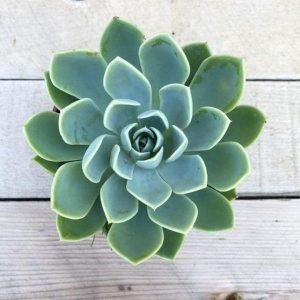Echeveria elegans : Succulent Plant
1) Name of Plant (Common name/ Botanical name)- Succculent Plant / Echeveria elegans
2) Type of Plant (Indoor/ Outdoor)-Indoor
3) Size of pot -4 inches
4) Seasonal/ Perennial -Perennial
5) Flowering/ Foliage- Foliage
6) Place to keep- Bright indirect light
677 in stock
₹172.00 ₹480.00
677 in stock
-
All Plants, Best Selling Plants, Indoor Cactus & Succulents, Indoor Plants
Echeveria elegans : Succulent Plant
-64% All Plants, Best Selling Plants, Indoor Cactus & Succulents, Indoor Plants
All Plants, Best Selling Plants, Indoor Cactus & Succulents, Indoor PlantsEcheveria elegans : Succulent Plant
1) Name of Plant (Common name/ Botanical name)- Succculent Plant / Echeveria elegans
2) Type of Plant (Indoor/ Outdoor)-Indoor
3) Size of pot -4 inches
4) Seasonal/ Perennial -Perennial
5) Flowering/ Foliage- Foliage
6) Place to keep- Bright indirect light
SKU: n/a -
All Plants, Indoor Cactus & Succulents, Indoor Plants
Echeveria Perle Von Nurnberg : Succulent Plant
-66% All Plants, Indoor Cactus & Succulents, Indoor Plants
All Plants, Indoor Cactus & Succulents, Indoor PlantsEcheveria Perle Von Nurnberg : Succulent Plant
1) Name of Plant (Common name/ Botanical name)- Succulent plant / Echeveria perle von nurnberg
2) Type of Plant (Indoor/ Outdoor)-Indoor
3) Size of pot – 4 inches
4) Seasonal/ Perennial -Perennial
5) Flowering/ Foliage- Foliage
6) Place to keep- bright indirect light
SKU: n/a
Echeveria elegans
Description
Echeveria elegans is one of the most easily recognizable of its species. The light-green rosette does well indoors when given enough light. It is often referred to as “hens and chicks,” not to be confused with Sempervivum. Many Echeveria species are popular as ornamental garden plants. They are drought-resistant, although they do better with regular deep watering and fertilizing. Most Echeveria will tolerate shade and some frost, although hybrids tend to be less tolerant. Most lose their lower leaves in winter; as a result, after a few years, the plants lose their compact appearance and need to be re-rooted or propagated. In addition, if not removed, Echeveria shed leaves may decay, harboring fungus that can then infect the plant. Full sun to partial shade.
Plant Description
- Typical water needs for a succulent.
- Plant grows up to 8″ (20 cm) tall Plant grows up to 12″ (30.5 cm) wide.
- Zone 9a (Minimum 20° F | -6.7° C).
- Not cold hardy.
- Propagation by offsets and leaves.
- Generally non-toxic to humans and animals.
- Winter Dormant.
Echeveria elegans, also known as Mexican snowball or white Mexican rose, is a popular succulent prized for its attractive rosette shape and silvery-gray leaves. Here are some tips for planting and caring for Echeveria elegans:
Planting and Care of Echeveria elegans
Soil
- Use a well-draining succulent or cactus potting mix. You can also create your own mix using equal parts of potting soil, perlite, and coarse sand.
Light
- Echeveria elegans thrives in bright, indirect light. A south-facing window where it can receive at least 4-6 hours of sunlight per day is ideal. If grown outdoors, provide partial shade during the hottest part of the day.
Temperature
- These succulents prefer temperatures between 65-75°F (18-24°C) during the day and cooler temperatures at night. They can tolerate brief periods of higher temperatures but should be protected from extreme heat.
Watering Echeveria elegans
- Water Echeveria elegans deeply but infrequently. Allow the soil to dry out completely between waterings, especially during the winter dormant period. In general, water once every 2-3 weeks during the growing season, reducing frequency in winter.
Humidity
- Echeverias prefer low humidity environments. Avoid placing them in very humid conditions, as this can increase the risk of fungal diseases.
Fertilizer
- Feed sparingly with a balanced, water-soluble fertilizer diluted to half strength during the growing season (spring and summer), approximately once every 4-6 weeks. Avoid fertilizing during the winter dormant period.
Pruning of Echeveria elegans
- Remove any dead or dried leaves by gently pulling them from the base of the plant. This helps maintain the health and appearance of the Echeveria.
Propagation
- Echeverias can be propagated easily from leaf cuttings or offsets (small plants that grow at the base of the main rosette). Allow cuttings or offsets to callous for a few days before planting in well-draining soil.
Pests and Diseases
- Monitor for common succulent pests such as aphids, mealybugs, or spider mites. Treat infestations promptly with insecticidal soap or a diluted rubbing alcohol solution.
Features of Echeveria elegans
- Plants may be evergreen or deciduous.
- Flowers on short stalks (cymes) arise from compact rosettes of succulent fleshy, often brightly coloured leaves.
- Species are polycarpic, meaning that they may flower and set seed many times over the course of their lifetimes.
- Many species of Echeveria serve important environmental roles, such as those of host plants for butterflies.
- It is a large genus of flowering plants in the family Crassulaceae, native to semi-desert areas of Central America, Mexico and northwestern South America.
- It can grow perfectly indoors.
Disclaimer : The image is for reference purposes only. The actual product may vary in shape or appearance based on climate, age, height, etc.
| size | Medium, Small |
|---|
Based on 1 review
Add a review
You must be logged in to post a review.











asha.negi0304 –
The plant arrives in healthy condition. Loved it.
asha.negi0304 –